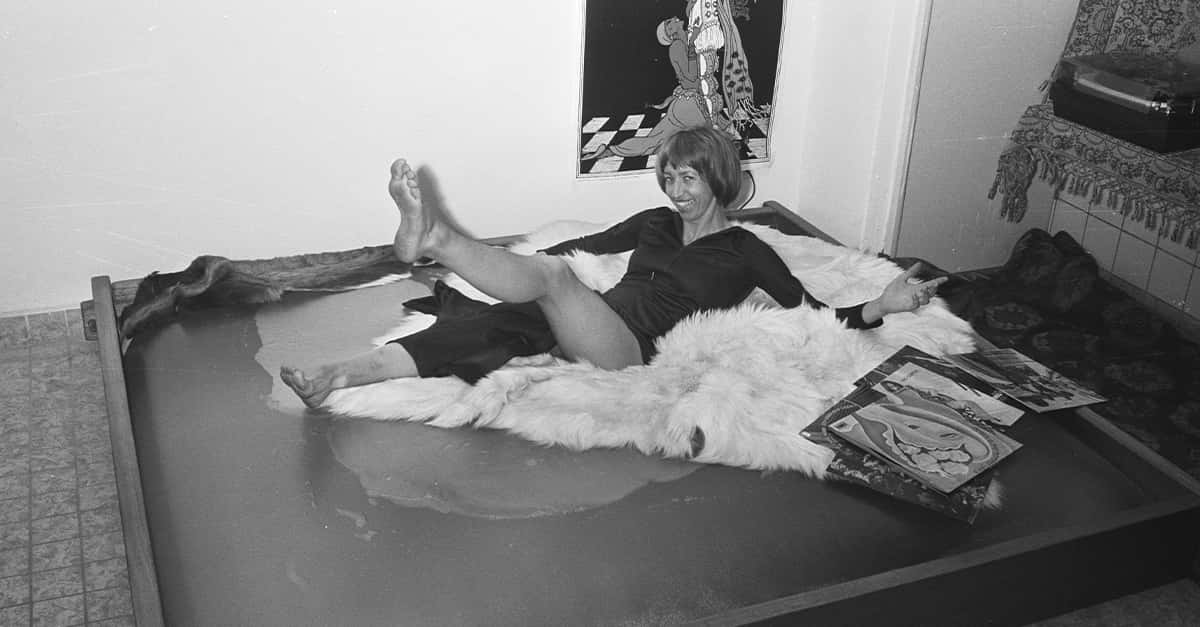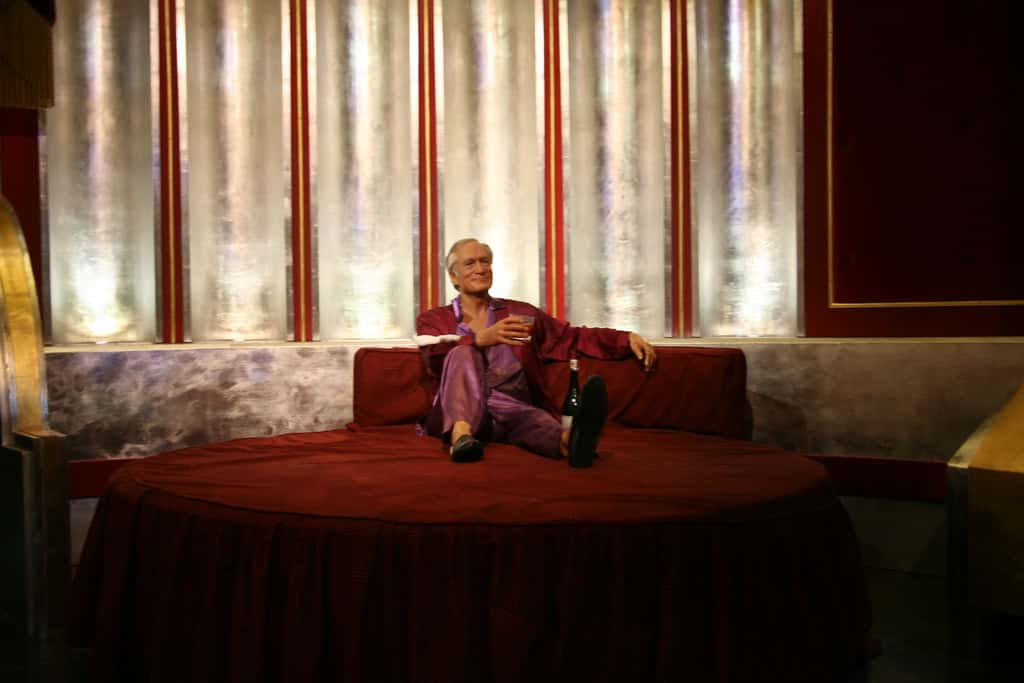We live in a time of wacky, weird, and most of all, plentiful consumer goods. Whatever you can think of, you can find it IRL or online—from drinks named for zombies or unicorns at Starbucks, to Squatty Pottys at “As Seen on TV”-themed stores, to the weirdest junk available on Wish.com: a home dental kit, a device to help people pee into water bottles for long trips, or a “Many Faces of Michael Scott” T-shirt.
The 1970s and 1980s were different, although they didn’t lack for their own share of zany consumer items—for example, the infamous pet rock. But one big-ticket item from that era seems to have all but disappeared from the collective consciousness, now relegated to a sleazy stereotype: the waterbed. But the waterbed wasn’t always fodder for greasy ladies’ man-types. It was an in-demand symbol of sexual freedom.
From Victorian Hospitals to Design Object to the Mass Market
The waterbed was actually invented—or at least, a form of it was—long before its heyday in the 70s and 80s. In 1833, Dr. Neil Arnott filled a rubberized canvas mattress with water in an attempt to prevent bedsores in his patients. Either altruistically or negligently, he failed to patent the invention, which meant that anyone caring for invalids—or looking for an alternative to other mattresses of the era—could make their own waterbed, if they had access to the same materials.
Throughout the 19th century, a waterbed of this type was occasionally mentioned in literature, usually in use by a bedridden patient, appearing in works by H.G. Wells and Elizabeth Gaskell, and once referenced by Mark Twain in a New York Times article.
 Wikimedia Commons
Wikimedia Commons
The dream of the waterbed as the ultimate hospital bed remained unrealized in the 20th century until 1968—when it was re-invented and re-imagined by a design student named Charles Prior Hall. His design left behind the idea of the waterbed as a medical accessory. In fact, Hall had originally wished to design a chair—but, as Mies Van der Rohe famously said, “A chair is a very difficult object. A skyscraper is almost easier.”
The young design student had set out to make a newfangled form of chair for his thesis project, and came up with a large vinyl bag filled with cornstarch (coincidentally, that same year, the iconic “Sacco” bean bag chair was being invented in Italy). While Hall’s chair didn’t work out, he adapted what he learned into the creation of a new type of bed. When he finally settled on a project, he filed a patent, which used the phrase “liquid support for human bodies.” The modern waterbed was born.
Famously, when Hall debuted the thesis project, other projects at the design student showcase were ignored—people preferred to bounce around on the waterbed. Hall’s prototype was made of vinyl, and the water was heated. Within a few years, Hall had created Innerspace Environments, a company which made, marketed, and sold his waterbeds. In reality, their intended usage wasn’t that different from the Victorian model created by Dr. Arnott—Hall thought that the design would relieve tension on pressure points, and that the temperate control could help relax muscles.

The Waterbed Lifestyle
Of course, Charles Hall Prior and Innerspace Environments weren’t the only ones making waterbeds. And while Prior may have had every intention of changing the way that people experience comfort as they sleep with his product, other waterbed manufacturers and sellers had a very different idea. It’s the oldest trick in the book: they would sell the waterbed by selling sex.
 Indistinguishable Levels of Sexiness
Indistinguishable Levels of Sexiness
It wasn’t a tough association for marketers to make in the minds of consumers. After all, it was a newfangled type of bed that had a thoroughly kinetic quality to it—the “motion of the ocean” and “if the boat’s a rockin’, don’t come a-knockin’” jokes write themselves. 1968, the year that Hall created the waterbed, was also the year that featured the infamous “summer of love.” Sexual liberation was the hot topic of the era, and the waterbed landed smack in the middle of the sexual revolution. It would ride that wave (pun intended) for the duration of its popularity.

Eventually, Hall played into this connotation for his product. He had set up an atelier where he made bespoke water beds, and claimed to have made one upholstered with green velvet for Playboy founder Hugh Hefner. It was also rumored that Hefner had another waterbed covered in Tasmanian opossum fur. To each their own…

Boom and Bust
Just as the hippies became yuppies, the waterbed went from accessory of the sexual revolution to another faux-glamorous lifestyle accoutrement via home decor, to be placed in between a high-gloss seashell-shaped vanity and a glass cube wall. It still had the sexual connotations, but it was also garish, an emblem of the Robin Leach, Lifestyles of the Rich and Famous-type era. If anything, the fact that knockoffs could be purchased for about $100 heightened this image—if a product’s not being copied, is it even worth having?
Waterbeds continued to see massive sales throughout the 80s. In 1989, it was reported that waterbeds were a $2 billion-a-year industry. Just two years earlier, waterbed sales had made up 22% of mattress sales domestically. It may not seem like a lot, but think about it—has there ever been a time when, say, bean bag chair sales made up 22% of chair sales overall? But just as quickly as there was a boom, there was a bust—or really, a bust that involved a series of bursts.

A Sinking Ship
Some of those aforementioned knockoffs may explain why people stopped buying waterbeds. The cheaper imitators of more luxurious models sprung leaks, burst, or deflated, and were difficult to repair. Even as companies like Innerspace and their contemporaries made innovations to the waterbed, lesser versions proliferated, selling versions with a single water chamber that created major wave movement that could be difficult to stabilize for a relaxing sleep.
On top of that, both the expensive and cheap versions were cumbersome, heavy, and impossible to move if you were unfortunate enough to have to move homes with one. Usually, the installation called for a professional, so they often were left behind during a move—imagine that surprise in a new apartment or house.
This is, of course, not to mention the fact that the waterbed’s image had gone from sexy to sleazy—something that was definitely no longer in vogue in the minimalist 90s. The waterbed soon became a trope. It was the bed of choice for Leon, Saturday Night Live’s resident Ladies Man, and the same for Morris Fletcher, a lecherous Men in Black agent who takes over Agent Mulder’s body (and makes moves on Agent Scully) in The X-Files, or about 100 one-off jokes on The Simpsons and Seinfeld.
Even the waterbed salesman became a trope, a variation on the used car salesman (but just a little sadder): Jack Nicholson’s daughter’s fiancé in About Schmidt, and the main character, a struggling cartoonist, on the animated sitcom Mission Hill.
Part of the decline of the waterbed may also have been due to economical factors. As the economy weakened in the late 80s and early 90s, cumbersome luxury items like the waterbed went the way of the dodo. Similarly, in the years following the 2008 recession, a change in the mattress industry reflected the instability of many people’s lifestyles, as inexpensive mattress-in-a-box companies like Casper and Endy popped up. An essential part of their marketing involves just how small the mattress is when it’s sent, making it somewhat the antithesis of the unwieldy and inconvenient waterbed.
All of this isn’t to say that waterbeds have disappeared completely—they can still be found new for sale on Amazon, some for just about $100. Unsurprisingly, Hall gives a lot of credit to his own invention for the way we sleep today, telling the New York Times in 2013 that, “It used to be ‘firmer is better,’” until waterbeds “changed what people look for in a mattress. The Tempur-Pedic and the memory-foam things and pillow tops are all about making a bed conform to you.”
Hall, for the record, still sleeps on a waterbed every night, saying, "In each house I have a water bed. And you know what? I wouldn’t sleep on anything else. They are the most comfortable bed around."
















